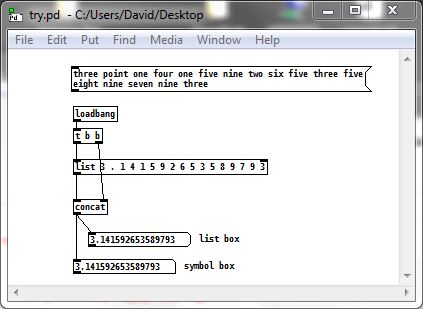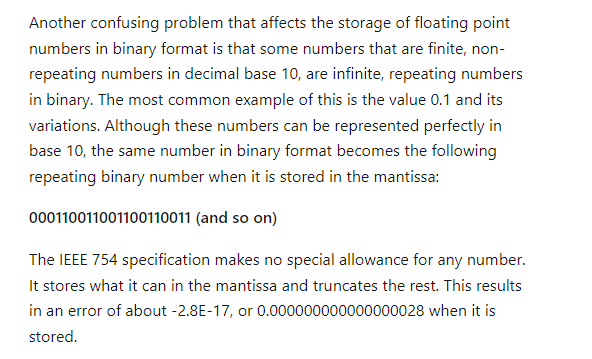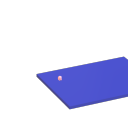I remember someone posting a link to a site that had this compiled executable labelled as an "experimental release", but I can't find it now. Maybe it was it on an IEM page? If you know, please tell me where I could download it from.
-
Pd compiled for double-precision floats and Windows
-
@jameslo A long time ago, but still useful information as always from @katjav ....... https://www.katjaas.nl/doubleprecision/doubleprecision.html
Yes.... experimental 64-bit double precision is here........ https://puredata.info/downloads/pure-data/releases/0.54-1-pd64
David. -
@whale-av Thanks!
-
Aw, the UI still rounds to single-precision, that's no fun! So you still can't store a double-precision float in a message or an array, or display it in a number box

Edit: to be clear, of course you can store a DP float in those objects, but their precision won't be preserved when you reload the patch. So you have to initialize any precision-sensitive variables each time with a loadbang.
-
mmmh that's bad news.
@jameslo do you know these threads? Maybe they help:
https://forum.pdpatchrepo.info/topic/13710/how-to-calculate-with-higher-precision/5
https://forum.pdpatchrepo.info/topic/709/symbol-to-float-conversion/17
Also I think @porres Else has more double stuff, but not sure about this? -
@jameslo said:
Aw, the UI still rounds to single-precision, that's no fun! So you still can't store a double-precision float in a message or an array, or display it in a number box
You know, "regular" Pd can't display numbers in single-precision. The display precision is less. For instance, you can represent any number with 7 digits or less in 32-bit float, but Pd can only display 6 significant digits.
I say this because you seem to imply that "regular" Pd can properly display 32-bit float and double precision should display 64-bit values. Know what I mean?
ELSE is not yet compiled for Pd64, as it is not "official" yet. Many objects in Pd single precision can use 'double' in the code internally, but it gets truncated when output.
cheers
-
@porres said:
Know what I mean?
I do! That also makes me sad, but it's more of a familiar, worn-in sadness.
 But what this experimental release of Pd64 does is worse by 8 or 9 digits! 3.141592653589793 becomes 3.14159
But what this experimental release of Pd64 does is worse by 8 or 9 digits! 3.141592653589793 becomes 3.14159 -
@jameslo said:
But what this experimental release of Pd64 does is worse by 8 or 9 digits!
It is, and I'm not sure why and how, but I think there's also an issue regarding what you can save on a Pd file and make it compatible I guess? You'd then need to have a special code and Pd file to run Pd64.
Anyway, how does this break your leg?
We can also bring this up to the Pd list and stuff.
-
@jameslo Try "three point one four one five nine two six five three five eight nine seven nine three".... it works....

The only way I can display (on reloading a patch) a precise number is as a symbol......... so not very useful.
concat.zip
David.

-
@porres He he he...I gotta remember that expression.
it just makes double-precision less usable, that's all. Most programming languages try to make language features orthogonal, which not only helps with usability but also makes them easier to learn. RE file compatibility, the languages I've used do anything from silently convert from one precision to another, to warning you before they do it, to demanding that you explicitly cast one type to the next. As we've been discussing, Pd already knows how to silently convert, so that might be an option.
I'm not a language designer and I don't know the goals and culture of Pd development, so I'm hesitant to make specific recommendations (or even call them "recommendations"). I'm really just telling you what I naively expected when downloaded this experimental release.
-
@whale-av The workaround I found is the same one I use in single-precision Pd when I really want to save all 7 digits to disk (uh, I mean "hard drive", uh, I mean "non-volatile memory"), which is to prepend numbers with an escaped space and save them as a symbol in a text object. And to display numbers I've been using [makefile %.15e] with a symbol box.
-
@jameslo said:
I naively expected when downloaded this experimental release.
I also did, and I think we can raise a discussion on the list on why can't we have the best precision possible for both single and double
-
yes
12 years ago:
[PD] why does PD round numbers? (in tables, in messageboxes, etc)
https://lists.puredata.info/pipermail/pd-list/2012-04/095892.html -
I wouldn't treat Pd as a 'proper language'
-
@porres Why not? Or do you just mean it is not safe to expect what is generally safe to expect in programming languages?
-
-
@porres said:
I also did, and I think we can raise a discussion on the list on why can't we have the best precision possible for both single and double
FWIW: Some years ago, SuperCollider changed double-to-string rendering to 17 digits of precision (sc language uses double precision, while audio is single precision), and... users freaked out because suddenly e.g. 1/10 would print out as 0.10000000000000001. "But it's not exact, where are those extra digits coming from" -- many many user complaints, until we reverted that change and now print 14 digits instead.
That is, "best precision" may not be the same as maximum precision.
Though I'd agree that clamping doubles to single precision in object boxes seems a pointless restriction.
hjh
-
@ddw_music I love that story but am scratching my head over the 1/10 example you gave. Here's a test I made in Arduino c++:

I went out 40 digits and didn't see anything unexpected. Was that example you gave just a metaphor for the issue, or is my test naive?Getting back to how Pd seems to differ from other programming languages, I'm going to hazard a guess and say that Pd hasn't separated the value of a float from its display/storage format. In my Arduino code I declare values, but it's not until the print statements that I specify their display formats. It's similar in Java and c#. I wonder if Pd could do something similar without upsetting users or making it too unfriendly? Maybe number boxes and arrays have an extra property that is a numeric format string? Or set messages for messages end in a numeric format string? Format strings shouldn't be too unfamiliar to those who've used makefilename. And if the format string is missing, then Pd defaults to it's current single-precision truncation strategy?
PS I hope my attempt at humor didn't discourage @porres from responding to @oid's question. I'm sure he would have something more meaningful to contribute.
Edit: hmm, but here's Pd64.

Yet another edit: I found this in Microsoft Excel help, but it suggests the value should be slightly less, not more that 0.1. Plus, Excel shows 0.1 exactly.

Yet another edit edit: disregard my comment about expecting it to be less, I didn't account for normalization of the mantissa. Carry on. -
@jameslo said:
@ddw_music I love that story but am scratching my head over the 1/10 example you gave. Here's a test I made in Arduino c++: ... I went out 40 digits and didn't see anything unexpected. Was that example you gave just a metaphor for the issue, or is my test naive?
Not a metaphor at all:
[16, 17, 40].do { |prec| "% digits: %\n".postf( prec, 0.1.asStringPrec(prec) ) }; 16 digits: 0.1 17 digits: 0.10000000000000001 40 digits: 0.1000000000000000055511151231257827021182As for Arduino, the float datatype reference says "Unlike other platforms, where you can get more precision by using a double (e.g. up to 15 digits), on the Arduino, double is the same size as float" -- so my guess here is that Serial places a limit on the number of digits it will try to render, and then fills the rest with zeros.
I went out 40 digits and didn't see anything unexpected.
Seeing zeros all the way out to 40 digits is unexpected! Arduino's output here is more comforting to end-users (which might be why they did that), but it isn't accurate.
Considering that Arduino calculates "double" using single precision, the output should deviate from the mathematically true value even earlier:
// 0.1.as32Bits = single precision but as an integer // Float.from32Bits = double precision but based on the 32 bit float Float.from32Bits(0.1.as32Bits).asStringPrec(40) -> 0.100000001490116119384765625The most reasonable conclusion I can draw is that Arduino is gussying up the output to reduce the number of "what the xxx is it printing" questions on their forum. That should not be taken as a standard against which other software libraries may be judged.
Edit: hmm, but here's Pd64.

Pd64 is doing it right, and Arduino is not.
Getting back to how Pd seems to differ from other programming languages, I'm going to hazard a guess and say that Pd hasn't separated the value of a float from its display/storage format.
The value must be stored in standard single/double precision format. You need the CPU to be able to take advantage of floating point instructions.
It's rather that Pd has to render the arguments as text, and this part isn't syncing up with the "double" compiler switch.
PS I hope my attempt at humor didn't discourage @porres from responding to @oid's question. I'm sure he would have something more meaningful to contribute.
Of patchers as programming languages... well, I got a lot of opinions about that. Another time. For now, just to say, classical algorithms are much harder to express in patchers because patchers are missing a few key features of programming languages.
hjh




